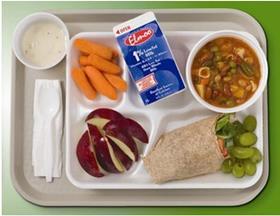
The US Department of Agriculture (USDA) has published a proposed rule to update the nutrition standards for meals served through the National School Lunch and School Breakfast programmes across the US.
The proposal, which forms part of the Healthy, Hunger-Free Kids Act of 2010, signed into law by President Barack Obama on 13 December, would significantly increase the amount of fresh fruits and vegetables served to 32m US students.
The USDA said the new proposed meal requirements would raise standards for the first time in 15 years and would add more fruits, vegetables, whole grains, fat-free and low-fat milk to school meals, based on recommendations released in October 2009 by the National Academies’ Institute of Medicine (IOM) and presented in their report, School Meals: Building Blocks for Healthy Children.
Schools would also be required to limit the levels of saturated fat, sodium, calories, and trans fats in meals.
The proposed rule seeks to align the National School Breakfast and Lunch Programs with the 2005 Dietary Guidelines and Institute of Medicine’s recommendations, both of which call for increased consumption of fruits and vegetables.
All schools would be expected to implement the proposed rule beginning in school year 2012/13.
“The United States is facing an obesity epidemic and the crisis of poor diets threatens the future of our children – and our nation,” said US Agriculture Secretary Tom Vilsack.
“With many children consuming as many as half their daily calories at school, strengthening nutritional standards is an important step in the Obama administration’s effort to combat childhood obesity and improve the health and wellbeing of all our kids.”
The United Fresh Produce Association is cheering the proposal, with Dr Lorelei DiSogra, United’s vice-president of nutrition and health, going as far as to say that fruits and vegetables are “the stars” of this proposed rule.
“We are pleased that the proposed rule will double the amount of fruit served at breakfast, double the amount of fruits and vegetables served at lunch and increase variety,” Dr DiSogra said in a United Fresh statement.
“Children like fresh fruits and vegetables and will eat more when they are available in school meals. Increasing children’s consumption of fruits and vegetables will improve their health and reduce their risk of childhood obesity.”
While the initial analysis of the proposed rule is very positive for fruits and vegetables, United Fresh said there are still many details to examine that will impact the produce industry.
As such, the association has formed a working group to review the rule and provide comprehensive comments back to USDA within the 90-day comment period.



